Olympus Zuiko Digital ED 12-60mm f/2.8-4 SWD
Handling and features
This 12-60mm lens offers a field of view equivalent to a 24-120mm lens on a 35mm camera, with a relatively bright maximum aperture of f/2.8-4. Costing around £940, this lens fits into Olympus' mid-to-high end range of lenses and promises to provide the world's fastest autofocus speeds, thanks to the silent SWD focusing motor.
Alternatives for Four Thirds SLRs include Olympus' 14-54mm f/2.8-3.5 II lens, which costs around £580 but has a slightly narrower zoom range, and no silent focusing motor. Panasonic's 14-50mm f/2.8-3.5 may also be a suitable alternative, costing around £785, although this also lacks the range and silent focusing motor of the Olympus 12-60mm.
In this review we will investigate how well this optic performs.
Olympus Zuiko Digital ED 12-60mm f/2.8-4 SWD: Handling and features
Weighing 575g, this lens isn't overly heavy and balances nicely on the Olympus E-3 used for testing. High quality materials have been used in the construction and the lens feels very solidly put together, plus it is also sealed against dust and moisture.
The lens accepts 72mm filters and as focusing is performed internally, the filter thread doesn't rotate, making polarising filter easy to use. As the lens is zoomed in it extends by just under two inches. The zoom mechanism is smooth and has enough resistance to prevent zoom creep when the camera is pointed towards the ground.
The manual focus ring is well damped, making it easy to make fine adjustments. Auto focus is extremely quick and virtually silent on the Olympus E-3 used for testing and the minimum focus distance of 0.25m is useful for frame-filling close ups at 60mm.
Olympus Zuiko Digital ED 12-60mm f/2.8-4 SWD: Performance
At 12mm and f/2.8 the sharpness in the centre of the image area is already very good, and the quality towards the edges isn't too far behind. Peak quality across the frame at this focal length is achieved at f/5.6, where the sharpness in the centre is outstanding, and the quality towards the edges approaches excellent levels.
With the lens zoomed to 25mm, the sharpness in the centre is excellent from maximum aperture, and the quality towards the edges isn't far off good. Peak quality across the frame is also achieved at f/5.6 at this focal length, where the sharpness is excellent in the centre of the image, and very good towards the edges.
Finally at 60mm, sharpness at f/4 is good in the centre and the quality towards the edges isn't too far behind. Again, peak quality across the frame is achieved at f/5.6, where the resolution is excellent in the centre and good towards the edges of the frame.
Chromatic aberrations are well controlled throughout the zoom range. At their most prominent fringing can cover up to 0.64 pixel widths, which shouldn't pose an issue, even in very large prints or harsh crops from the edge of the frame.
Falloff of illumination towards the corners is well controlled. At 12mm and f/2.8 the corners are 1.33 stops darker than the image centre and visually uniform images are achieved at f/5.6. At 60mm the corners are only 0.662stops darker than the image centre at f/4 and visually uniform images are achieved at f/5.6.
Imatest detected barrelling of 3.9% at 12mm, which is quite pronounced and may be an issue when photographing subjects where straight lines are paramount. At 60mm, the barrelling is replaced with 0.779% pincushion distortion, which will rarely be noticeable. At both ends of the zoom range the distortion pattern is uniform across the frame, which should make it simple to correct in image editing software afterwards.
During testing there were few issues with flare or loss of contrast. When shooting directly in to the sun a slight loss of contrast can be seen, but not to the extent that may be found with other similar lenses. A petal shaped hood is provided with the lens, which does an excellent job of keeping extraneous light from causing problems.
Olympus Zuiko Digital ED 12-60mm f/2.8-4 SWD: Verdict
Overall this lens performs very well indeed. In terms of resolution, control of chromatic aberrations, focusing speed and the build quality it is an excellent lens. The barrel distortion at 12mm may be an issue for some, but this is generally to be expected with a high zoom ratio like this.
The flexibility offered by the high zoom range, close focusing and relatively bright maximum aperture should help this lens find many a fan amongst Four Thirds format SLR owners.
Olympus Zuiko Digital ED 12-60mm f/2.8-4 SWD: Pros
 Excellent build quality
Excellent build quality
 Good optical performance
Good optical performance
 Fast focusing
Fast focusing
 Useful minimum focus distance
Useful minimum focus distance
Olympus Zuiko Digital ED 12-60mm f/2.8-4 SWD: Cons
 Barrel distortion at 12mm
Barrel distortion at 12mm
Olympus Zuiko Digital ED 12-60mm f/2.8-4 SWD: Lens specification
The Olympus Zuiko Digital ED 12-60mm f/2.8-4 SWD costs around £940 and is available from Warehouse Express here:
Olympus Zuiko Digital ED 12-60mm f/2.8-4 SWD
 |
| Gary Wolstenholme takes a close look at this standard zoom for Four thirds SLRs from Olympus. |
This 12-60mm lens offers a field of view equivalent to a 24-120mm lens on a 35mm camera, with a relatively bright maximum aperture of f/2.8-4. Costing around £940, this lens fits into Olympus' mid-to-high end range of lenses and promises to provide the world's fastest autofocus speeds, thanks to the silent SWD focusing motor.
Alternatives for Four Thirds SLRs include Olympus' 14-54mm f/2.8-3.5 II lens, which costs around £580 but has a slightly narrower zoom range, and no silent focusing motor. Panasonic's 14-50mm f/2.8-3.5 may also be a suitable alternative, costing around £785, although this also lacks the range and silent focusing motor of the Olympus 12-60mm.
In this review we will investigate how well this optic performs.
Olympus Zuiko Digital ED 12-60mm f/2.8-4 SWD: Handling and features
Weighing 575g, this lens isn't overly heavy and balances nicely on the Olympus E-3 used for testing. High quality materials have been used in the construction and the lens feels very solidly put together, plus it is also sealed against dust and moisture.
The lens accepts 72mm filters and as focusing is performed internally, the filter thread doesn't rotate, making polarising filter easy to use. As the lens is zoomed in it extends by just under two inches. The zoom mechanism is smooth and has enough resistance to prevent zoom creep when the camera is pointed towards the ground.
The manual focus ring is well damped, making it easy to make fine adjustments. Auto focus is extremely quick and virtually silent on the Olympus E-3 used for testing and the minimum focus distance of 0.25m is useful for frame-filling close ups at 60mm.
Olympus Zuiko Digital ED 12-60mm f/2.8-4 SWD: Performance
At 12mm and f/2.8 the sharpness in the centre of the image area is already very good, and the quality towards the edges isn't too far behind. Peak quality across the frame at this focal length is achieved at f/5.6, where the sharpness in the centre is outstanding, and the quality towards the edges approaches excellent levels.
With the lens zoomed to 25mm, the sharpness in the centre is excellent from maximum aperture, and the quality towards the edges isn't far off good. Peak quality across the frame is also achieved at f/5.6 at this focal length, where the sharpness is excellent in the centre of the image, and very good towards the edges.
Finally at 60mm, sharpness at f/4 is good in the centre and the quality towards the edges isn't too far behind. Again, peak quality across the frame is achieved at f/5.6, where the resolution is excellent in the centre and good towards the edges of the frame.
| Resolution at 12mm | Resolution at 25mm |
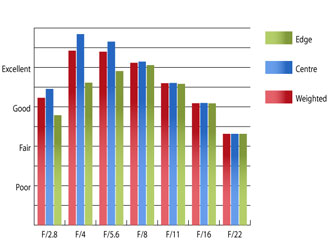 | 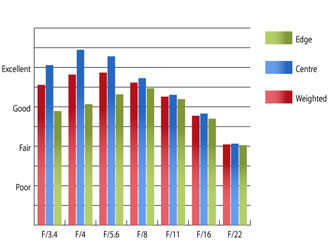 |
| Resolution at 60mm | How to read our graphs The blue column represents readings from the centre of the picture frame at the various apertures and the green is from the edges. Averaging them out gives the red weighted column. The scale on the left side is an indication of actual image resolution. The taller the column, the better the lens performance. Simple. For this review, the lens was tested on an Olympus E-30 using Imatest. |
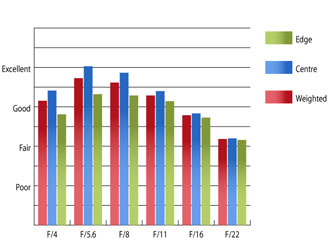 |
Chromatic aberrations are well controlled throughout the zoom range. At their most prominent fringing can cover up to 0.64 pixel widths, which shouldn't pose an issue, even in very large prints or harsh crops from the edge of the frame.
Falloff of illumination towards the corners is well controlled. At 12mm and f/2.8 the corners are 1.33 stops darker than the image centre and visually uniform images are achieved at f/5.6. At 60mm the corners are only 0.662stops darker than the image centre at f/4 and visually uniform images are achieved at f/5.6.
Imatest detected barrelling of 3.9% at 12mm, which is quite pronounced and may be an issue when photographing subjects where straight lines are paramount. At 60mm, the barrelling is replaced with 0.779% pincushion distortion, which will rarely be noticeable. At both ends of the zoom range the distortion pattern is uniform across the frame, which should make it simple to correct in image editing software afterwards.
| Chromatic Aberrations at 12mm | Chromatic Aberrations at 25mm |
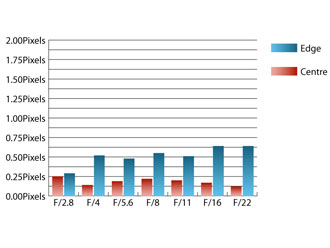 | 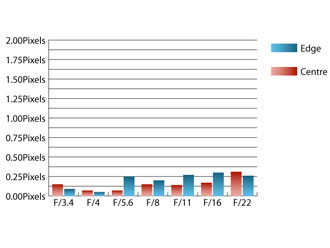 |
| Chromatic Aberrations at 60mm | How to read our charts Chromatic aberration is the lens' inability to focus on the sensor or film all colours of visible light at the same point. Severe chromatic aberration gives a noticeable fringing or a halo effect around sharp edges within the picture. It can be cured in software. Apochromatic lenses have special lens elements (aspheric, extra-low dispersion etc) to minimize the problem, hence they usually cost more. For this review, the lens was tested on an Olympus E-30 using Imatest. |
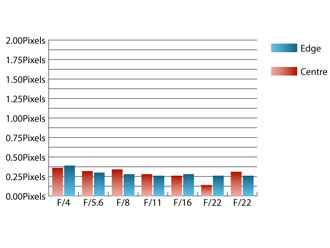 |
During testing there were few issues with flare or loss of contrast. When shooting directly in to the sun a slight loss of contrast can be seen, but not to the extent that may be found with other similar lenses. A petal shaped hood is provided with the lens, which does an excellent job of keeping extraneous light from causing problems.
 |  |
| Maximum Magnification – ISO100, 1/125, f/8, 60mm | Shooting into the light – ISO100, 1/125, f/8, 12mm |
 |  |
| Wide Angle – ISO100, 1/250, f/5.6, 12mm | Telephoto – ISO100m 1/125, f/5.6, 60mm |
Olympus Zuiko Digital ED 12-60mm f/2.8-4 SWD: Verdict
Overall this lens performs very well indeed. In terms of resolution, control of chromatic aberrations, focusing speed and the build quality it is an excellent lens. The barrel distortion at 12mm may be an issue for some, but this is generally to be expected with a high zoom ratio like this.
The flexibility offered by the high zoom range, close focusing and relatively bright maximum aperture should help this lens find many a fan amongst Four Thirds format SLR owners.
 |
| A great choice for those looking for a high quality, general purpose optic for Four Thirds. |
 Excellent build quality
Excellent build quality Good optical performance
Good optical performance Fast focusing
Fast focusing Useful minimum focus distance
Useful minimum focus distanceOlympus Zuiko Digital ED 12-60mm f/2.8-4 SWD: Cons
 Barrel distortion at 12mm
Barrel distortion at 12mm| FEATURES |  |
| HANDLING |  |
| PERFORMANCE |  |
| VALUE FOR MONEY |  |
| OVERALL |  |
Olympus Zuiko Digital ED 12-60mm f/2.8-4 SWD: Lens specification
| Price | £940.00 |
| Contact | www.olympus.co.uk |
| Filter size | 72mm |
| Format | Four Thirds |
| Construction | 14 elements in 10 groups |
| Angle-of-view | 84 - 20 ° |
| 35mm equivalent focal length (on APS-C body) | 24-120cm |
| Internal focusing | Yes |
| Image stabilisation | No |
| Minimum focus | 25cm |
| Maximum aperture | f/2.8-4 |
| Minimum aperture | f/22 |
| Weight | 575g |
| Size | 79.5 x 98.5mm |
| In the box | Operating Instructions, Warranty Card, Lens Caps, Lens Hood |
The Olympus Zuiko Digital ED 12-60mm f/2.8-4 SWD costs around £940 and is available from Warehouse Express here:
Olympus Zuiko Digital ED 12-60mm f/2.8-4 SWD
Add your message
Login required
Please login here or if you've not registered, you can register here. Registering is safe, quick and free.
Please login here or if you've not registered, you can register here. Registering is safe, quick and free.
photodo Stats
1102 lenses
428 MTF tests
74 in-depth photodo reviews
100+ users join each day
Help the lens community by reviewing or rating a lens today via our lens search
428 MTF tests
74 in-depth photodo reviews
100+ users join each day
Help the lens community by reviewing or rating a lens today via our lens search
Latest Lens Reviews
- Chinon 28mm f/2.8 Vintage Lens Review
- Canon EF 70-200mm f/4L IS II USM Lens Review
- Samyang AF 85mm f/1.4 EF Review
- Sigma 70mm f/2.8 DG Macro Art Review
- Samyang AF 24mm f/2.8 FE Review
- Meike 50mm f/1.7 Review
- Tamron 70-210mm f/4 Di VC USD Review
- Lensbaby Burnside 35mm f/2.8 Review
- Asahi Super Takumar 50mm f/1.4 Review
- Asahi Super-Multi-Coated Takumar 135mm f/3.5 Review
